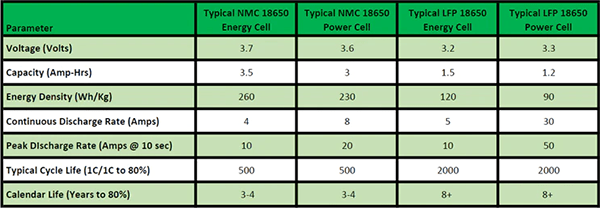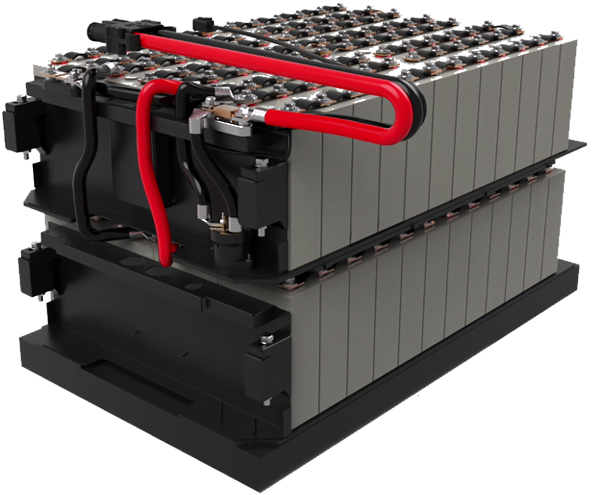An industry insider’s snapshot of Li-ion battery cells, covering the most popular sizes, formats, and chemistries. Given the diversity of Li-ion cells available, the focus is on cylindrical and prismatic cells in metal cases.
What you’ll learn:
- The latest trends in lithium-ion cell sizes, formats, and chemistries.
- What are the performance characteristics of popular lithium-ion cells?
- Who are the major cell suppliers for each lithium-ion cell chemistry?
The foundational building block of the batteries that supply power to everything from consumer electronics to electric vehicles is the lithium-ion cell.
Lithium-ion cells tend not to be standalone parts. They’re connected in series and parallel, forming a final assembly called a battery pack. But for each battery pack, the selected cell is what comes to define the lifespan and performance of the overall battery. The cell performance characteristics determine the size, weight, voltage, current, power, and environmental capabilities of the final battery pack.
Lithium-ion cells come in three basic form factors: cylindrical, prismatic (or brick-shaped), and the flat rectangular shape of lithium-polymer cells. The standard formats for metal-encased cylindrical cells are 18650 (18 mm in diameter × 65 mm tall), 21700 (21 × 70 mm), or 26650 (26 × 65 mm). Within cylindrical and prismatic cells, layers of battery material are rolled inside like a jelly roll. Lithium-ion cylindrical and prismatic cells are packaged in metal cans.
Prismatic, or brick-shaped, cells are often cost-effective and available in myriad sizes. One of the major features of a prismatic cell is the pressure vent with terminals on top of the metal can. The positive and negative terminals on the prismatic cell are tabs protruding from the cell. In multi-cell battery packs with space constraints, prismatics are recommended as their rectangular shape results in minimal air gaps between the cells.
Lithium-polymer cells, sometimes called “laminate” cells, are available in custom footprints. They can be very thin or bulky depending on the required format. The primary advantage of lithium-polymer batteries is the wide range of form factors available. These types of cells are encased in inflexible aluminum-foil laminate pouches that measure only 0.1-mm thick, compared to the 0.25- to 0.40-mm thickness of the aluminum or steel cans used to enclose cylindrical or prismatic cells. Unlike cylindrical cells, there aren’t many standard footprints in the lithium-polymer category. This results in an array of cell offerings.
Lithium-polymer cells are preferred by major manufacturers of smartphones and other portable devices because they offer more flexible footprints. Over the last decade, many personal computers have shifted from cylindrical to lithium-polymer cells, opening the door to thinner, lighter laptops and tablets.
Cell Chemistry Trends
With lithium-ion cells, the underlying chemistry determines the performance characteristics of the cells. Lots of cell chemistries have been introduced over the last decade, and clear trends have emerged from each of these formulas. The most common cell chemistries are lithium cobalt oxide (LCO), lithium nickel cobalt aluminum oxide (NCA), lithium nickel manganese cobalt oxide (NMC), and lithium iron phosphate (LFP).
Ten years ago, LCO was the most common chemistry for cylindrical and prismatic cells. However, NMC has vaulted ahead with the best performance characteristics of all cell chemistries. It’s also more economical as it uses less cobalt, which is in limited supply and expensive.
Nickel and manganese enhance each other’s characteristics, and variations of the basic formula result in more advanced, higher power cells. Industry analysts estimate that NMC will account for 20% of all lithium-ion battery cells on the market by 2025. In addition, NMC is the preference for manufacturers of electric vehicles (EVs). The leading NMC cell manufacturers include BYD, LG, Murata, Panasonic/Sanyo, and Samsung.
The LFP chemistry also offers good electrochemical performance with low impedance, as it uses a phosphate material for the cathode. Key advantages are high current delivery and exceptional cycle life, good thermal stability, and superior safety against abusive conditions. These types of cells have an intrinsically safer cathode material than NMC batteries and don’t decompose at higher temperatures. Lithium-ion cells tend to contain highly flammable substances; if they’re damaged or overcharged, they can overheat uncontrollably in a thermal runaway. The overheating may result in smoke, fires, or even explosions.
LFP batteries provide the best thermal and chemical stability. In addition, because LFP has less energy density (in both volume and weight), and a higher cost per watt-hour than LCO, NCA, NMC, or LFP batteries, it’s ideal for applications that need high-power ratings, long cycle life, or elevated operating temperatures. Traditionally, there’s been very little overlap of LCO/NCA/NMC and LFP in their specific applications. The leading LFP cell manufacturers include BAK, BYD, CALB, and CATL.
NMC battery cells are displacing LFP cells in some applications due to increasing power ratings, high energy density, and lower cost per watt-hour. They’re also starting to replace LFP cells in high-power systems, such as power tools, batteries for material handling equipment, and powertrains for electric buses.
For each cell chemistry, segmentation exists within each category as battery manufacturers push their products to the high-energy or high-power segment of the market. We’re starting to see more overlap between high-power NMC and high-energy LFP cells. In many cases, there’s no longer a clearly superior cell chemistry for a specific set of performance requirements.
Green Cubes Technology manufactures battery packs for many industrial applications, and the company generally uses NMC or LFP cells. The performance gap between NMC and LFP is closing.
Cell Format Trends
To review: Lithium-ion cells packed in metal enclosures come in two shapes—cylindrical and prismatic.
Cylindrical cells come in many formats, but traditionally, the most popular format for the LCO, NCA, and NMC battery cells has been the 18650. And when Panasonic partnered with Tesla to create a new EV battery, they developed the unique 21700 cell format.
Expanding the 18650 cell dimensions by several millimeters (Fig. 1) results in a 50% volumetric increase for the battery’s active material. This cell size is now currently supported by most leading NMC cell manufacturers. As a result, the 18650 and 21700 are the two most common formats for NMC chemistry. If you select a 18650 or 21700 cell to construct a NMC battery pack, finding an alternate cell with similar performance is assured given the standardization.

1. The illustration compares the 18650 and 21700 cell sizes.
According to industry analysts, more than 2 billion cells based on the 21700 format were shipped in 2020, a 25% increase over the previous year. These types of cells also accounted for 24% of all cylindrical batteries shipped in 2020, other estimates show. The 26650 cell isn’t commonly paired with the NMC chemistry. Smaller prismatic NMC formats, such as the 103450 (10 × 34 × 50 mm), have fallen out of favor in recent years as lithium-polymer cells have become more popular.
For LFP cells, the 18650 and 26650 formats are common; both tend to be offered by leading LFP cell manufacturers (Fig. 2). That enables dual sourcing from competing cell manufacturers when choosing LFP cells for a battery pack. The 26650 format has been largely limited to the LFP cell chemistry. Large prismatic LFP cells, in the 50- to 100-Ah range, have risen in popularity over the last several years.

2. Performance characteristics of typical 18650 NMC and LFP cells.
Larger LFP prismatic formats are commonly used in electric vehicles or industrial equipment such as forklifts (Fig. 3). These batteries are classified as medium- or large-format, and demand very-high-power ratings. Unfortunately, standards are scarce for large-format prismatic LFP cells, so any cell selected for a battery pack will be single-sourced from a specific manufacturer.

3. This medium-format forklift battery is based on 100-Ah LFP cells.
Conclusion
When developing a mobile or portable device that uses lithium-ion batteries to supply power, it’s important to keep in mind the various cell formats and chemistries on the market. Cell selection is the most critical decision in the early design stage of not only the battery pack, but also the end device. Choosing a lithium-ion format and chemistry with market momentum can help guarantee a long lifecycle for the cell and provide a roadmap of performance and cost improvements throughout the cell’s life.
Jeffrey VanZwol



